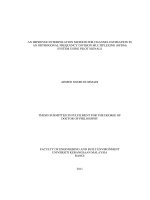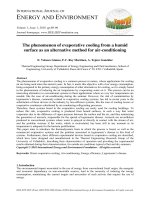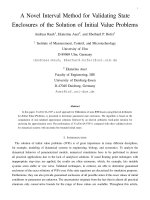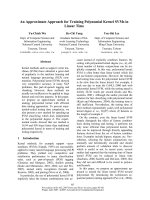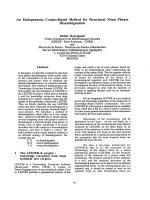16 an interval method for linear IVPs for ODEs nedialkok
Bạn đang xem bản rút gọn của tài liệu. Xem và tải ngay bản đầy đủ của tài liệu tại đây (119.74 KB, 30 trang )
1
An Interval Method for
Linear IVPs for ODEs
Ned Nedialkov
Department of Computing and Software
McMaster University, Canada
Joint work with Qiang Song
McMaster University
Improved version of the talk given at the
Workshop on Taylor Models
17–20 December 2003, Miami, Florida
2
The Problem
Enclose the solution of a sy stem of n ≥ 2 equations IV P
y
= A(t)y + g(t), y(0) = y
0
∈ [y
0
].
Idea (Lohner, Nickel)
• Perform (n + 1) integrations of points specifying a parallelepiped
at t
i
and enclose each point solution at t
i+1
.
We have (n + 1) boxes.
• Find (n + 1) points that determine a parallelepiped, which
encloses all the parallelepipeds with vertices in these boxes.
• Repeat.
3
1 2 3 4
1
1.5
2
2.5
3
3.5
(a)
2 2.5 3 3.5 4
1.5
2
2.5
3
(b)
2 3 4
1
1.5
2
2.5
3
3.5
(c)
2 3 4
1
1.5
2
2.5
3
3.5
(d)
Figure 1: (a) enclosures of point solutions at t
1
; (b) some of the par-
allelepipeds with vertices in these enclosures (boxes); the larger b ox
contains the fourth vertices; (c–d) parallelepipeds enclosing the true
solution
4
1 2 3 4
1
1.5
2
2.5
3
3.5
(a)
2 2.5 3 3.5 4
1.5
2
2.5
3
(b)
2 2.5 3 3.5 4
1.5
2
2.5
3
(c)
2 2.5 3 3.5 4
1.5
2
2.5
3
(d)
Figure 2: The same computation as in the previous figure, except that
the width of each component of the enclosures is 2 × 10
−10
. The boxes
are denoted by “+”.
5
0.5 1 1.5 2
0.5
1
1.5
2
(a)
0.5 1 1.5
0.4
0.6
0.8
1
1.2
1.4
1.6
(b)
−2 0 2 4
−1
0
1
2
3
(c)
−2 0 2 4
−1
0
1
2
3
(d)
Figure 3: (a) enclosures of point solutions at t
1
; (b) some of the par-
allelepipeds with vertices in these enclosures (boxes); the larger b ox
contains the fourth vertices; (c–d) parallelepipeds enclosing the true
solution
6
0.5 1 1.5 2
0.5
1
1.5
2
(a)
0.5 1 1.5
0.5
1
1.5
(b)
0.5 1 1.5
0.5
1
1.5
(c)
0.5 1 1.5
0.5
1
1.5
(d)
Figure 4: The same computation as in the previous figure, except that
the width of each component of the enclosures is 2 × 10
−10
. The boxes
are denoted by “+”.
7
Advantages
• We enclose point solutions:
Taylor series + remainder term.
• The method does not impose restrictions on the size of the initial
box.
• An automatic differentiation package for computing Taylor
coefficients for the solution to Y
= A(t)Y , Y (0) = I is not
needed.
These coefficients are computed in AWA and VNODE.
Difficulties
• How to compute (n + 1) points on each step such that the
parallelepiped specified by them encloses the solution set.
• How to achieve small overestimations and reduce the wrapping
effect.
8
Outline
1. Enclosing point solutions
2. Computing a parallelepiped
3. Choice of a transformation matrix
4. Reducing the wrapping effect
5. Concluding remarks
9
Enclosing Point Solutions
Denote by f
i
(·) the ith Taylor coefficient of the solution to
y
= A(t)y + g(t). (1)
If h and [y
0
] y
0
are such that
y
0
+
p−1
i=1
t
i
f
i
(y
0
) + t
p
f
p
([y
0
]) ⊆ [y
0
] for all t ∈ [0, h],
then (1) w ith y(0) = y
0
has a unique solution in [0, h], and
y(t; t
0
, y
0
) ∈ [y
0
] for all t ∈ [0, h].
At t = h,
y(h; t
0
, y
0
) ∈ y
0
+
p−1
i=1
h
i
f
i
(y
0
) + h
p
f
p
([y
0
]).
10
Assume that at a point t
i
, for all y
0
∈ [y
0
],
y(t
i
; t
0
, y
0
) ∈ { b
0
+ Bα | α ∈ [0, 1]
n
},
where B ∈ R
n×n
, and [0, 1]
n
denotes the vector with each component
[0, 1].
We integrate v
0
= b
0
, v
1
= b
0
+ b
1
, . . . , v
n
= b
0
+ b
n
to compute [w
0
], [w
1
], . . . , [w
n
].
That is, for each v
j
,
y
t
i+1
; t
i
, v
j
∈ [w
j
]
= v
j
+
p−1
i=1
h
i
f
i
(v
j
) + h
p
f
p
([v
j
]),
where v
j
∈ [v
j
].
11
Computing a Parallelepiped
Denote
c
j
= mid([w
j
]),
[e
j
] = [w
j
] − c
j
, j = 0, . . . , n,
C the n × n matrix with jth column c
j
− c
0
, and
[e] =
n
j=1
[e
j
] + (n − 1)[e
0
].
For all y
i
∈ { b
0
+ Bα | α ∈ [0, 1]
n
},
y(t
i+1
; t
i
, y
i
) ∈
w
0
+
n
j=1
α
j
(w
j
− w
0
) | α
j
∈ [0, 1], w
j
∈ [w
j
]
⊆
c
0
+ Cα + [e] | α ∈ [0, 1]
n
,
12
since for α ∈ [0, 1]
n
, w
j
∈ [w
j
], and e
j
= w
j
− c
j
∈ [e
j
] (j = 0, . . . , n),
w
0
+
n
j=1
α
j
(w
j
− w
0
)
= c
0
+ Cα + (w
0
− c
0
) +
n
j=1
α
j
w
j
− w
0
− (c
j
− c
0
)
= c
0
+ Cα + e
0
+
n
j=1
α
j
(e
j
− e
0
)
= c
0
+ Cα +
n
j=1
α
j
e
j
+ (1 −
n
j=1
α
j
)e
0
∈
c
0
+ Cα +
n
j=1
[e
j
] + (n − 1)[e
0
] | α ∈ [0, 1]
n
=
c
0
+ Cα + [e] | α ∈ [0, 1]
n
.
(Note that each [e
j
] is symmetric.)
13
1 1.5 2 2.5 3 3.5 4 4.5
0.5
1
1.5
2
2.5
3
3.5
4
4.5
{c
0
+ Cα | α ∈ [0,1]
n
}
{c
0
+ Cα + [e] | α ∈ [0,1]
n
}
Figure 5: We want to enclose the set
c
0
+ Cα + [e] | α ∈ [0, 1]
n
by
a parallelepiped.
14
We want to find g
0
and G such that
{ c
0
+ Cα + e | α ∈ [0, 1]
n
, e ∈ [e] } ⊆ { g
0
+ Gα | α ∈ [0, 1]
n
}.
Let H ∈ R
n×n
be nonsingular.
Denote
[r] = (H
−1
C)[0, 1]
n
+ H
−1
[e] and D = diag
w([r])
.
Then
c
0
+ Cα + e | α ∈ [0, 1]
n
, e ∈ [e]
= { c
0
+ H
(H
−1
C)α + H
−1
e
| α ∈ [0, 1]
n
, e ∈ [e] }
⊆ { c
0
+ Hr | r ∈ [r] }
= { c
0
+ Hr + Hr | r ∈ [0, r − r] = D[0, 1]
n
}
= { (c
0
+ Hr) + (HD)α | α ∈ [0, 1]
n
}
= { g
0
+ Gα | α ∈ [0, 1]
n
}.
This derivation is by R. Lohner (2001, private communications).
15
Now, for all y
i
∈ { b
0
+ Bα | α ∈ [0, 1]
n
},
y(t
i+1
; t
i
, y
i
) ∈ { g
0
+ Gα | α ∈ [0, 1]
n
}.
We integrate g
0
, (g
0
+ g
1
), . . . , (g
0
+ g
n
).
Subtlety: we compute in floating-point arithmetic g
0
and
G
corresponding to g
0
and G.
Is
{ c
0
+ Cα + e | α ∈ [0, 1]
n
, e ∈ [e] } ⊆ { g
0
+
Gα | α ∈ [0, 1]
n
} ? (2)
If
G
−1
(c
0
− g
0
) + (
G
−1
C)[0, 1]
n
+
G
−1
[e] ⊆ [0, 1]
n
(3)
then (2) holds.
If (3) does not hold in computer arithmetic, inflate [e] and try again.
16
Choice of a Transformation Matrix
Parallelepiped method
H = C,
[r] = (H
−1
C)[0, 1]
n
+ H
−1
[e] = [0, 1]
n
+ C
−1
[e].
This method breaks down when C is close to singular.
QR-factorization method
C = QR, H = Q,
[r] = (H
−1
C)[0, 1]
n
+ H
−1
[e] = R[0, 1]
n
+ Q
T
[e].
17
1 1.5 2 2.5 3 3.5 4 4.5
0.5
1
1.5
2
2.5
3
3.5
4
4.5
Parallelepiped
QR
Figure 6: Enclosures obtained by the parallelepiped and QR approaches.
18
On some problems, with a large initial box, the QR method can
produce large overestimations.
Example:
y
=
1 −2
3 −4
y, y(0) ∈ ([1, 2], [1, 2])
T
.
We take [e] = [−10
−3
, 10
−3
], h = 0.2.
The eigenvalues of exp(hA) are ≈ 0.8187 and 0.6703.
19
0.6 0.8 1 1.2 1.4 1.6 1.8
0.8
1
1.2
1.4
1.6
step 1
0 0.5 1
0
0.2
0.4
0.6
0.8
1
step 5
−0.2 0 0.2 0.4 0.6
−0.1
0
0.1
0.2
0.3
0.4
0.5
0.6
step 9
−0.1 0 0.1 0.2 0.3
−0.05
0
0.05
0.1
0.15
0.2
0.25
0.3
step 13
Figure 7: QR; the blue lines denote the true solution set.
20
0.6 0.8 1 1.2 1.4 1.6 1.8
0.8
1
1.2
1.4
1.6
step 1
0 0.5 1
0
0.2
0.4
0.6
0.8
1
step 5
−0.4 −0.2 0 0.2 0.4 0.6 0.8
−0.2
0
0.2
0.4
0.6
0.8
step 9
−1 −0.5 0 0.5 1
−0.5
0
0.5
1
step 13
Figure 8: Parallelepiped; the vertices of the true solution are denoted
by “+”.
21
Example:
y
=
−0.5 1
−1 0
y, y(0) ∈ ([1, 2], [1, 2])
T
.
We take [e] = [−10
−4
, 10
−4
], h = 0.2.
The eigenvalues of exp(hA) are ≈ 0.9334 ± 0.1831i, and
ρ
exp(hA)
≈ 0.9512.
22
0.5 1 1.5
1.2
1.4
1.6
1.8
2
2.2
step 1
−0.15 −0.1 −0.05 0 0.05 0.1
−0.25
−0.2
−0.15
−0.1
step 51
−0.03 −0.02 −0.01 0 0.01 0.02
0
0.01
0.02
0.03
step 101
−0.01 −0.005 0 0.005 0.01
−8
−6
−4
−2
0
2
4
6
x 10
−3
step 151
Figure 9: QR and parallelepiped methods
23
Reducing the Wrapping Effect
The true solution is in
{ g
0
+ Gα | α ∈ [0, 1]
n
}
= { c
0
+ Hr | r ∈ (H
−1
C)[0, 1]
n
+ H
−1
[e] }.
Parallelepiped
H = C, [r
p
] = [0, 1]
n
+ C
−1
[e].
QR factorization
C = QR, H = Q, [r
q
] = R[0, 1]
n
+ Q
T
[e].
Can we combine them, or switch between them at run time?
Two ad-hoc solutions: Approach I and II.
24
Approach I
We can (roughly) measure the overestimations in the parallelepiped
and QR methods by
w
C[r
p
]
and
w
Q[r
q
]
, respectively.
Select:
if
w
C[r
p
]
≤
w
Q[r
q
]
H = C, [r] = [r
p
] (parallelepiped)
else
H = Q, [r] = [r
q
] (QR)
25
Example:
y
=
1 −2
3 −4
y, y(0) ∈ ([1, 2], [1, 2])
T
,
[e] = [−10
−3
, 10
−3
], h = 0.2.
